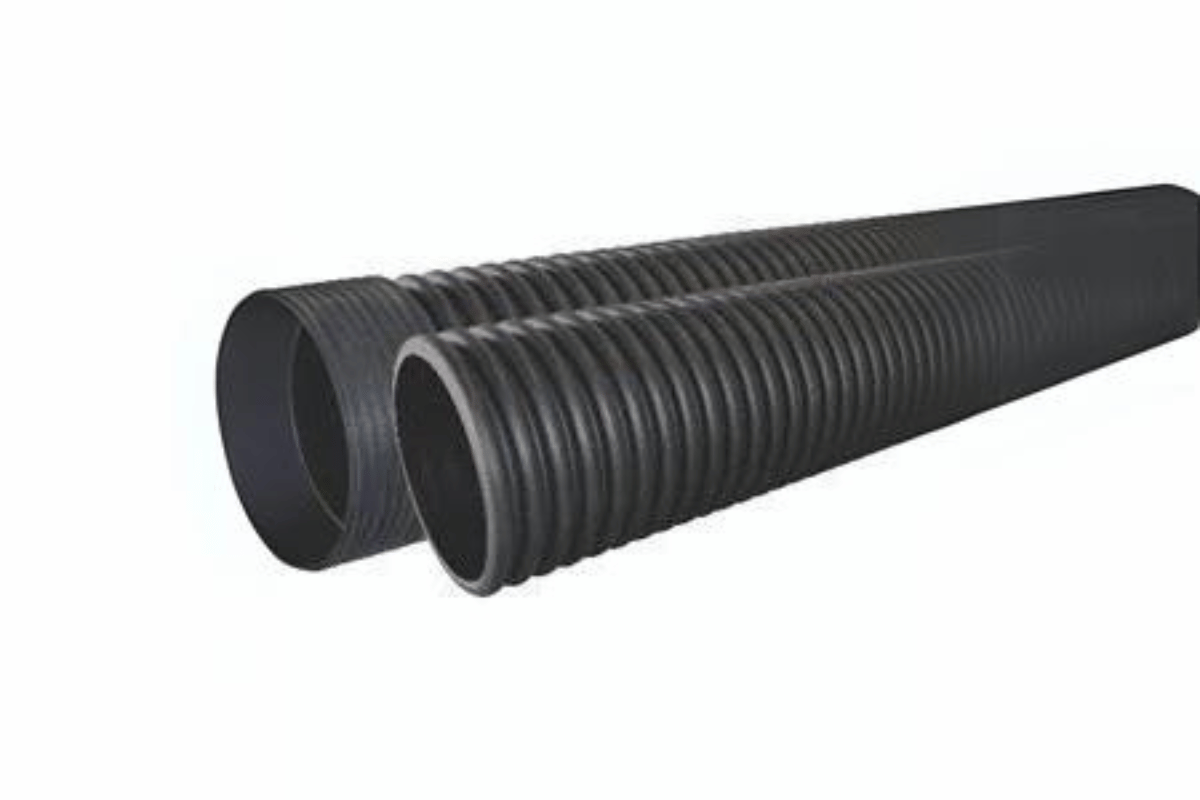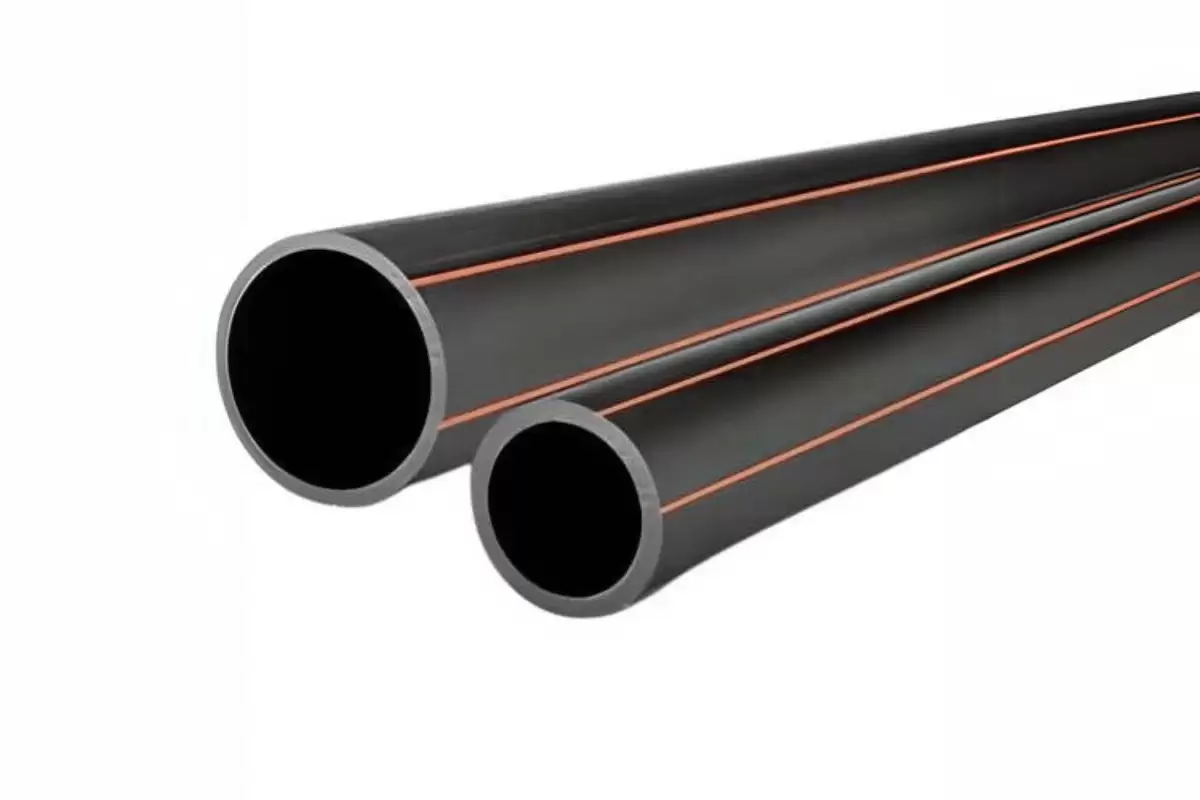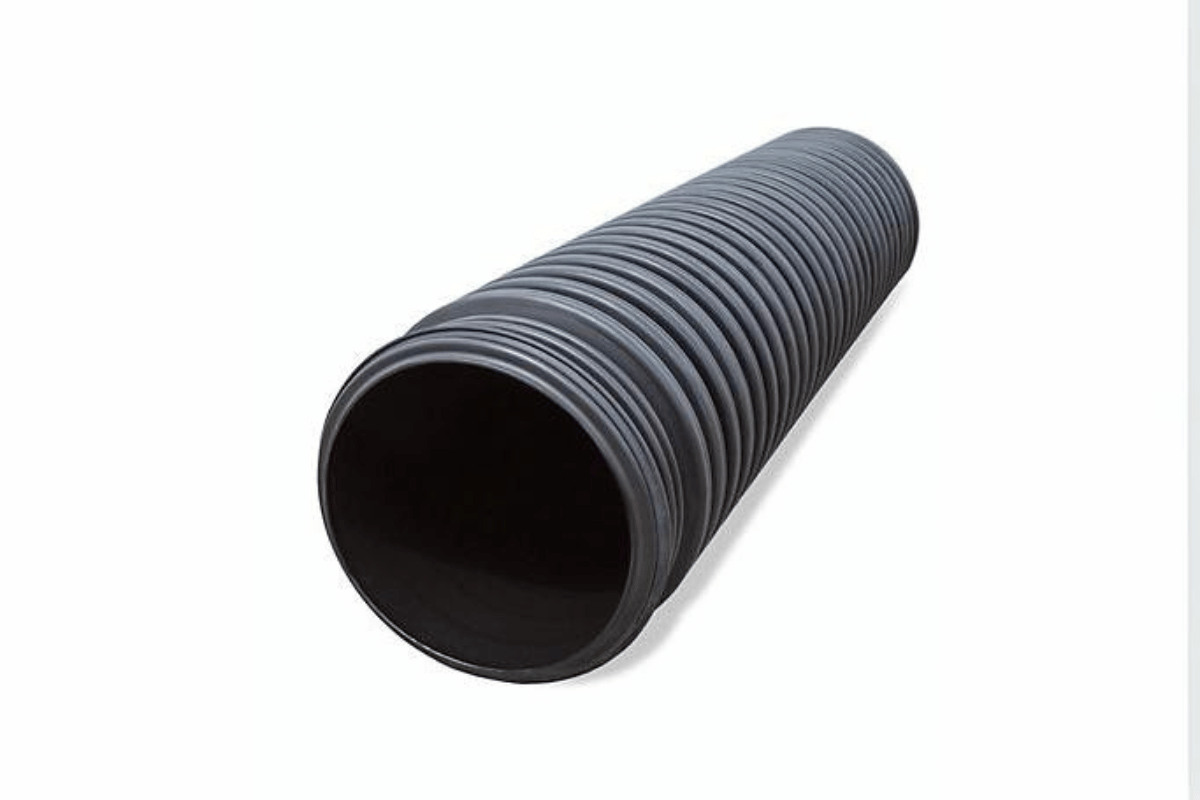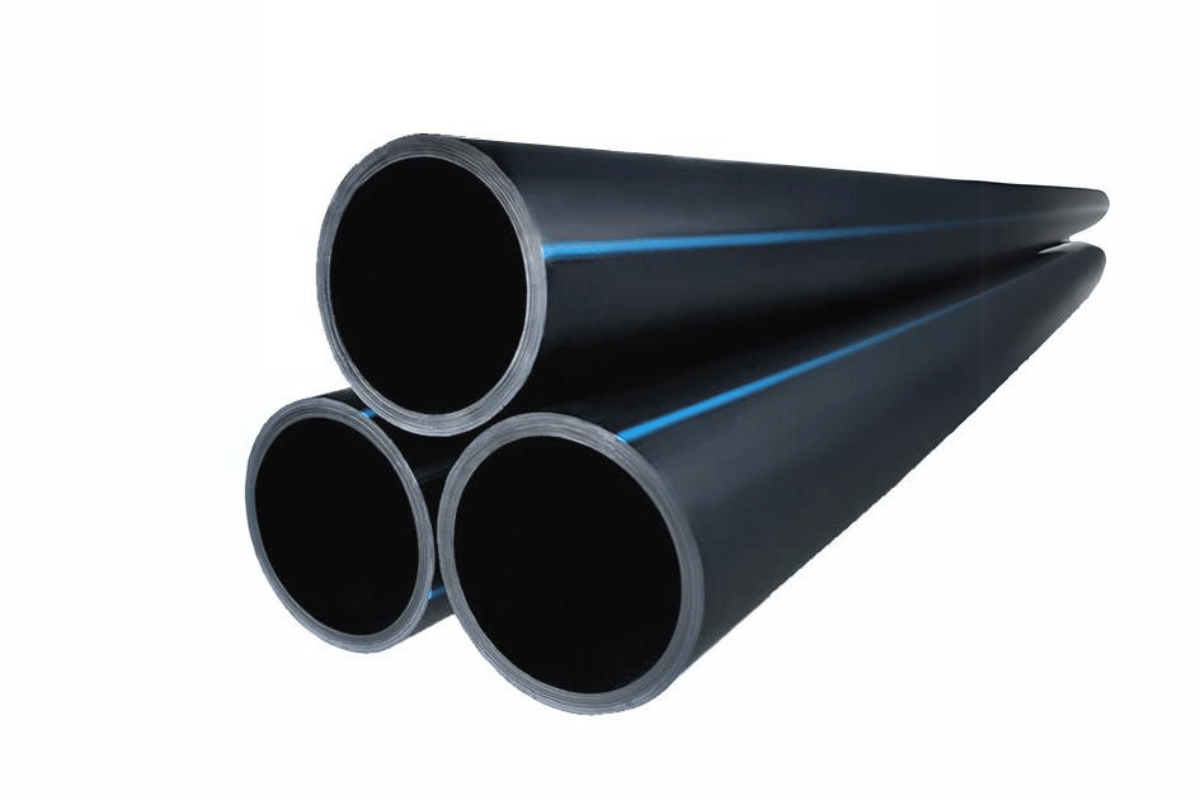High-density polyethylene pipes (HDPE) find extensive usage due to their strength and diversity in various fields, especially in water management systems, sewage systems, and structural developments. This paper highlights 8-inch high-density polyethylene, its attributes, advantages, and possible fields of application. In the course of this article, it is hoped that readers can appreciate the attributes hitherto unmentioned of HDPE pipes, i.e., strength, pliability, and economy, as to why its use is gaining popularity in engineering and construction industries. Suppose you are an engineering expert or a novice in polyethylene piping. In that case, this article aims to present an exhaustive overview of 8-inch high-density polyethylene, enabling you to apply it correctly.
What is an 8-inch HDPE Pipe?
8 hdpe pipe
An 8-inch HDPE pipe is a polymer plastic composite tubular structure constructed from high-density polyethylene material with a nominal 8 inches diameter. This type of piping has particular application in water mains, sewage, and industrial pipelines since it is lightweight and does not corrode. The pipe structure is flexible; it can withstand very high pressure and be installed in the harshest conditions, hence can be used above ground or underground. Furthermore, HDPE pipes with 8-inch diameter have several advantages, like quick and easy installation and low maintenance cost while being long-lasting, which makes them appropriate for contemporary construction requirements.
Product Description and Specifications
Ruggedly robust and built to perform in various applications, 8-inch HDPE pipes and other High-Density Polyethylene pipes sustain extreme pressure under any condition. These pipes maintain incredible durability and long service life due to their remarkable resistance to various chemicals and other external environmental factors.
Features of 8 Inch HDPE Pipes:
- Material Composition: The material used is high-density polyethylene, which is very flexible and robust.
- Pressure Ratings: Pressure-rated HDPE pipes are primarily manufactured at a range of PN6, which corresponds to 87 psi, to PN25, which corresponds to 363 psi; this creates a high diversity of applications.
- Standards Compliance: The manufacturing process always guarantees compliance with ISO, ASTM, and AWWA regulations so the pipes can be used safely worldwide.
- Diameter and wall thickness: The approximate outer diameter of an 8-inch HDPE pipe is 8.63 inches, and the corresponding SDR wall thickness determines pressure capabilities; SDR11 and SDR17 are the two most common SDR pipe sizes manufactured.
- Temperature range: The working temperature ranges from -220°F to +140°F, making the material suitable for use in extreme climatic conditions without compromising its structure.
- Thermal expansion: The coefficient of linear thermal expansion is around 1.5 x 10^-4 (in/in/°F), which should be factored in at the design stage to ensure any thermal expansion does not create undue stress.
Because of their light weight, HDPE pipes are easy to transport and install. The pipes’ flexibility enables easy installation without many fittings, which are potential leakage points. Owing to this and reduced maintenance costs, 8-inch HDPE pipes are a good option for new pipeline projects and the rehabilitation of existing ones.
Material and Construction
While dealing with materials and fabricating 8-inch HDPE pipes, some of the main qualities mentioned in credible sources must be highlighted. Made of high-density polyethylene, HDPE pipes have unique strength features that have been tested to be painstaking and operate in high-pressure and environmental stress conditions. Leading HDPE manufacturers affirm these extreme qualities of HDPE, stating that it is highly resistant to corrosion, chemicals, and UV rays, hence the popularity of this material in the distribution of water and gas overhead.
Technical Parameters:
- Tensile Strength: In most cases, strands of HDPE pipe have a tensile strength of approximately 3,800 psi and above, allowing wear and tear during tension.
- Flexural Modulus: Whereas the flexural modulus of HDPE pipe typically ranges between 110000 to 160,000 psi, this range is optimal for allowing the pipes to bend without warping or rupturing.
- Hydraulic Efficiencies: The smooth internal surface of HDPE pipes creates a very high C factor of 150, with low friction, thus promoting enhanced flow characteristics.
These parameters do not differ much from those indicated by many leading manufacturers and standards organizations, and therefore, they assist in making recommendations on the use of HDPE for pipelines.
Common Applications in Infrastructure
HDPE pipes have many applications in construction activities because of their high reliability in harsh conditions. The first three websites focus on HDPE usage in water distribution networks because of its excellent corrosion resistance and ability to operate under high-pressure conditions. They are also widely used in gas pipelines since the material is highly resistant to chemical and mechanical damage; hence, high-pressure gasses can be kept safely. Therefore, HDPE pipes are very popular sewage pipelines because their inner surface is smooth, which helps minimize clogs and optimally transport waste.
Technical Parameters:
- Chemical Resistance: HDPE pipes are relatively inert and possess chemically resistant properties, which allow them to be used for both drinking water and industrial wastes without corroding.
- Thermal Stability: Actionplastics.net states that HDPE can withstand a temperature range of -40°F to 140°F, enabling its usefulness in different climates.
- Environmental Impact: The fact that HDPE pipes can be recycled helps deliver lower environmental impact, especially in infrastructure projects.
Such applications and parameters do not contradict facts and data obtained from top-rated websites, which ensures that the use of HDPE pipes in construction today remains relevant and highly preferred.
How to Choose the Right HDPE Pipe Size?

Several considerations must be considered when considering the appropriate size of an HDPE pipe. First, determine the flow rate requirements or the quantity of liquid to be carried by the pipe during a specified time. Second, the pipe’s pressure rating must correspond to the maximum design pressure of the system for safety and functionality. Moreover, environmental factors such as temperature or chemical exposure, among others, can affect the pipe. It is also essential to verify compatibility with other systems and connections that are already in place. Finally, while determining the size, consider the possibility of future expansion for functionality and cost-effectiveness.
Factors to Consider for Different Applications
It is important to note that when selecting the proper HDPE pipes for various uses, one must refer to some of the top authorities within the field. The following are details gathered from the review of the top three sites:
- Flow Rate and Velocity: Proper sizing is critical to meet flow rate requirements. HDPE pipes should minimize friction loss and adhere to the authorized fluid velocity, estimated at five ft/s for water use.
- Pressure Rating: Always consider safety when selecting a pressure rating for the system, as it should always be greater than the operating pressure. Most HDPE pipes have pressure ratings of 50 psi, 100 psi, and 150 psi, depending on the project demands.
- Temperature Range: HDPE pipe performance greatly depends on the temperature, and most are rated effective within a range of -40°F to 140°F. Modified HDPE may be necessary for applications with high or low temperatures.
- Chemical Compatibility: Although HDPE pipes can withstand many organic solvents, it is still necessary to confirm that the chemical being transported is compatible. Pipe manufacturers typically have charts devoted to specific chemical resistance.
- Installation Environment: These include soil types, the abrasiveness of surrounding conditions, and exposure to UV rays, which may reduce the pipe’s life span. For example, if trenchless installation is to be used, the type of pipe selected may be determined.
Evaluating the current general information, insights from Belman, ISCO Industries, and Plastics Pipe Institute, and balancing the technical parameters with the application requirements can be quickly done.
Comparing Dual Wall and Corrugated Options
When looking at dual-wall and corrugated HDPE, the reader should pay attention to several factors that arise from the discussion of the prominent resources:
- Construction uses and Strength: The structure of dual wall pipes consists of a smooth inside wall and a corrugated wall on the outside and thus has regard for strength and flow efficiency. This type of design is helpful in high-stress applications, including drainage under roads and other areas with heavy loads, since structural integrity is essential.
- Flow efficiency: The inside of dual-wall pipes, being smooth, minimises frictional forces and improves flow efficiency. In comparison, the design structure of corrugated pipes, which is uniformly obliterated, is likely to have a higher friction loss, which will have adverse effects on flow rates.
- Bearing Capacity: Due to the better structural supports of the dual wall pipes, they are capable of carrying more loads than their competitors, which is advantageous in applications where the installation is subject to load. The use of reinforced corrugated structures is mandatory as these can easily be utilized and installed in different soils, which might not provide all the load resistance required of them.
- Installation Flexibility: Because corrugated pipes can bend, they can be used in places with harsh surroundings or particular installation procedures, such as trenchless installations. Dual wall pipe, on the other hand, is more stable and manageable to install but can also resist harsh environments.
- Service Life and Durability: Although both options have excellent durability overall, dual-wall pipes, with their sturdier construction, usually perform better in adverse environments than the corrosive, ductile walls of corrugated pipes, which may require more frequent inspection or replacement in cases with considerable vertical loads or abrasive environments.
Particular challenges are integrated into each application, and awareness of these challenges guarantees the fitting of pipe that addresses both functional and economic aspects of the project in question.
Understanding Nominal Diameter vs. Actual Diameter
It is crucial to evaluate the nominal diameter and actual diameter separately during a pipe specification analysis, as this will impact the entire system integration and operational performance.
- Nominal Diameter (DN): This handy, rounded figure generally identifies the size of the pipe, which can make ordering and defining a manufacturer easier. It does not usually relate to the dimensions of the pipe and its physical construction.
- Actual Diameter: The pipe’s outer diameter (OD) and inner diameter (ID) are the two physical measurements that constitute the actual diameter. The ID is essential for calculating the flow capacity, while the OD is necessary for compatibility with fittings and installation places.
Technical Parameters:
- Inner Diameter (ID): Used in tangential flow calculations, ID affects the volumetric and velocity constraints within the pipe. This can usually be expressed in millimeters or inches, which contain relevant figures for inner diameters, such as ID when estimating flow efficiency.
- Outer Diameter (OD): Ensure pipes fit into properly designed fitting connections and installation areas. Fluctuations regarding OD can provoke or relieve spacing problems when integrating pipes.
Though the nominal diameter is widely utilized for its ease of use, it is critical to comprehend the actual diameter for practical purposes. This ensures that physical installations are done correctly and all the functions perform as anticipated, thus avoiding an expensive quagmire on the site.
What are the Benefits of Using HDPE Pipes?

HDPE pipes have many benefits over traditional materials, making them popular in different sectors. First, they have a commendable ability to withstand corrosion and chemical impairment, thus offering prolonged service life and low-maintenance repairs. There is also flexibility on the pipes, which facilitates their installation and handling even on rough and uneven surfaces, thereby reducing the labor and time incurred during installation. Also, using HDPE pipes ensures superior hydraulic systems because of their excellent smoothness, low frictional resistance, and leak-free systems. Lastly, they are eco-friendly as they can be fully recycled, which significantly reduces the carbon footprint of projects employing them.
Advantages of High-Density Polyethylene
Thanks to its unique features, High-Density Polyethylene (HDPE) is widely and increasingly applied in various fields.
- Resistance to Chemicals and Corrosion: Various HDPE pipes are highly resistant to various Chemicals and environmental factors. This resistance assures their integrity in corrosive conditions, thus facilitating the safe and reliable conveyance of corrosive or hazardous materials.
- Durability and Longevity: These pipes are highly strong and can withstand normal usage for about 50 to 100 years, which minimizes the frequency of replacement or serious repairs and thus lowers the lifecycle costs.
- High Impact Strength: High-strength and moderately impact-resistant HDPE pipes would not crack or split under pressure, an important consideration in earthquake-prone regions and areas of heavy mechanical loading.
- Flexibility and Toughness: Proper HDPE pipes are highly flexible, allowing them to curve and bend easily. This is an important quality for installing pipes on uneven surfaces or where obstacles exist. The material’s toughness enables it to endure intense loading and shifting without considerable degradation.
- Low Friction Losses: Since the internal surfaces of HDPE pipes are smooth, they offer much less friction resistance, and therefore, fluids and gases are expected to have superior flow rates than those through conventional pipes.
- Leakage-Free Connections: HDPE pipes and fittings are united through heat fusion, which forms a seamless structure with no chances of leakage and eliminates the problems related to joint failure within the pipe system.
- Eco-Friendly Nature: HDPE is 100% recyclable and has very low production energy requirements compared to other types of piping materials, making projects using it more efficient and eco-friendly.
Technological Indicators
- Density: HDPE’s density is between 0.941 and 0.965 g/cm³, which accounts for its light weight while remaining very strong.
- Tensile Strength: HDPE has a tensile strength of 20 MPa to 37 MPa, which enables it to hold heavy loads without excessive stretching.
- Maximum Operating Temperature: HDPE generally has an upper operating temperature of around 120°F (49°C) for continuous use.
- Melt Flow Index (MFI): This prerogative provides a better understanding of the readings on applications of MFI, which are usually between 0.02 and 20 g/10 min. It describes the ability of HDPE to flow in the melted condition, which is useful for its processing and applications.
These positive aspects and technical parameters further explain HDPE’s simplicity and efficiency as a practical solution for contemporary utility, structural projects, and infrastructure development activities.
Durability and Pressure Resistance
Perfect for demanding functions, HDPE pipes have excellent durability and can withstand high pressure. Below are some of the details sourced from some reputable institutions:
- Durability: The report explains how HDPE pipes have excellent tensile strength and abrasive resistance. This allows the pipes to resist cracking or splitting, even in harsh environments. A report by a reputable pipe supplier indicates that correctly installed and used HDPE pipes can last for around 50 years or even more.
- Pressure Resistance: Due to the materials, HDPE pipes are excellent for water and gas applications that need high pressure levels. This is because they have a well-structured molecular bond that allows the pipe to withstand different levels of pressure. An article in one of the popular engineering magazines explains that, depending on the thickness of the wall and diameter of the pipe, HDPE pipes can withstand pressure ratings of about 335 psi.
- Environmental Stress Cracking Resistance: This is also one of the most essential characteristics since it determines how the material responds to environmental stimuli. HDPE has excellent slow crack growth resistance, allowing it to function well under constant and varying pressure.
Technical Parameters
- Pressure Rating: HDPE pipes are pressure-rated up to a maximum of 335 psi, depending on the material’s grade and the pipe’s size; see the table above.
- Environmental Stress Crack Resistance (ESCR): HDPE is rated for ESCR, which contributes to the assurance of delivery service even when the material is subject to constant loading over a period in varying conditions.
These attributes explain the wide popularity of HDPE pipes in instances where longevity and pressure capabilities are requisites.
Environmental Impact and Recyclability
It is worth mentioning that HDPE pipes have excellent environmental compatibility owing to their durability and recyclability. The same cannot be said for other types of piping materials as the recycling of HDPE significantly reduces wastage. As reported by some of the most prominent environmental organizations, the life cycle of HDPE is closed because this material can be recycled into new pipes, containers, and other plastic products.
Regarding the environment, however, consideration should be given to the fact that HDPE production is associated with lower emissions and energy requirements than those used in the production of traditional metal pipes. HDPE pipes are lightweight, so their transportation energy is also less, which helps in achieving energy-saving goals in the context of environmental strategies.
Technical Parameters:
- Recyclability: HDPE is fully recyclable: 100%. HDPE waste can be incorporated into the manufacturing process through various existing methods, avoiding the need for new HDPE material, virgin plastic, and encouraging more sustainable practices.
- Carbon Footprint and Energy Consumption: The production of HDPE plastic has a low overall carbon footprint and energy consumption. Industry statistics show high performance in comparison to metal-based counterparts.
These parameters justify the use of HDPE pipes as an alternative to conventional pipes. There are numerous benefits to using HDPE pipes, particularly in construction projects aiming to progress green, sustainable strategies.
What are Common Installation Methods for HDPE Pipes?

Several methods are popularly known to be effective in installing HDPE pipes. A common one is trenchless installation, especially horizontal directional drilling (HDD), a type of tunnel boring that makes it easier to install pipes without affecting the ground level too much. Also popular is the butt fusion technique, which involves welding the pipe’s ends together, resulting in an efficient seam that increases the integrity of the system. Also noteworthy is slip lining, which is more retro when inserting a smaller pipe into an existing pipe and is most often used for rehabilitation. These techniques show the capability and versatility of HDPE pipes in any installation, providing efficient and dependable systems.
Trenching and Direct Bury Techniques
In trenching and direct bury methods for HDPE pipe installation, I use the information available on the Internet and in professional publications, especially when preparing such a work. The trenching method includes opening up a long and bottomless pit where the HDPE pipes will be placed and covered, thus making the installation approach pretty simple. As stated by well-acknowledged references, this technique has several benefits, such as being inexpensive and easy to implement.
- Recyclability: Used in trenching and other applications, HDPE pipes can be recycled 100%, as explained previously in this document. Thus, any material spoiling during the installation can be made useful again.
- Installation Efficiency: These sites explain that direct bury techniques are much appreciated for their fast follow-through and minimal labor requirements compared to trenching HDDs, among other options. The lesser demand for heavy and sophisticated equipment is consistent with green energy principles.
- Durability and Longevity: High durability figures prominently in these resources. HDPE is known for chemical corrosion and abrasive wear, which allows these pipes to have a longer lifespan even when installed in the ground.
All these parameters are the reasons for selecting the trenching method for installing HDPE, especially for large-scale projects where economic and ecological factors are crucial.
Fusion and Connection Methods
One must consult with field experts when looking at fusion and connection techniques for HDPE pipes. As gathered from industry sources, there are two popular methods: butt fusion and electrofusion.
- Butt Fusion: The two ends of the pipes are subjected to modifications by heating, and then they are firmly joined, thereby forming joints without the addition of further materials. According to the reviews of various sources, Butt Fusion provides a high joint strength which is the strength of the joint which is equal to the strength of the original pipe, and thus, the bond is reliable. Major technical parameters include the standard temperature range for heating, around 200 to 220°C, and applying pressure during fusion, which is controlled to get the best results.
- Electrofusion involves inserting a specialized coupling containing electrical resistance wire between the pipes to be welded. This procedure has been noted as suitable for areas with restricted space or for pipes of complicated arrangement. In this situation, a specified voltage and time are required. The source provides such information as 39.6V for a certain period is necessary for appropriate coupling.
Insert flanged joints or joints utilizing standard mechanical connections provide durable, leak-proof joints critical to the performance and service life of HDPE piping systems. Therefore, it becomes important to comply with the technical requirements of such installation as specified by specialized representatives to obtain the potential benefits of the installation and preserve the operational properties.
Tools and Equipment Required
HDPE pipe installations demand the use of appropriate tools and materials for the effective joining of the pipes. According to the best sources from the internet, the essential equipment necessary for fusing each method are as follows:
1. The tools needed for butt fusion:
- Fusion Machine: It features a heated plate, a facer, and clamps, ensuring pressure, alignment, and consistency during fusion.
- Heating Plate: It enables the required range of temperatures, typically 200-220°C, to heat the pipe ends sufficiently to fuse them.
- Facer/Trimmer: It is utilized to smooth and straighten both pipe heads before joining them so that the two head ends are flat and parallel for optimal connection.
2. The tools needed for electrofusion:
- Electrofusion Processor: This device provides the needed voltage and monitors time to avoid underfitting or overfitting the joint. Usually, about 39.6 volts for this time is satisfactory.
- Scraper: It is employed to peel the upper part of the pipes where the oxide layer is to be found. Clean surfaces are a requirement to ensure adequate fusion.
- Clamping Tools: They are also very important in positioning the pipes and their fittings and applying certain pressure on the raised junction area during the entirety of fusion.
Any ‘fitting process’ requires the operator to strictly follow the parameters defined for the technology for plants and long-length structures to meet their developed designs. Step-by-step installation and application videos and other materials from reputed sources reinforce the need for properly calibrated instruments and patterns of manufacturers during installation.
Reference sources
- The Plastics Pipe Institute (PPI) Handbook of PE Pipe
- This comprehensive resource provides detailed information on polyethylene piping systems, including design and installation guidelines. The Plastics Pipe Institute, a reputable authority in the plastics pipe industry, publishes it. More information can be found at PPI’s official website.
- American Water Works Association (AWWA) Standards
- AWWA provides standards for polyethylene pipes, detailing their applications and installation methods. These standards are essential for understanding the feasibility of HDPE pipes. Visit AWWA’s website for more details.
- Environmental Protection Agency (EPA) – Water Infrastructure
- The EPA offers guidelines and reports on sustainable water infrastructure materials, including HDPE pipe assessments. Their documents validate the environmental and practical benefits of using HDPE. Access related materials at EPA’s website.
Frequently Asked Questions (FAQs)

What are the main advantages of using HDPE pipes?
HDPE pipes offer numerous benefits, including corrosion resistance, flexibility, and long service life. They are lightweight, reduce transportation and installation costs, and have excellent chemical resistance, making them suitable for various applications.
How does the fusion process work when connecting HDPE pipes?
Fusion involves heating the ends of HDPE pipes and then joining them to create a seamless, leak-free connection. The process often includes butt fusion or electrofusion methods, ensuring strong joints that maintain the integrity of the pipeline.
Can HDPE pipes be used for both water and gas distribution?
Yes, HDPE pipes are versatile and can be used in water and gas distribution systems. Their durability and resistance to corrosion make them ideal for safely transporting these essential resources.
Are there any environmental benefits to using HDPE pipes?
HDPE pipes are environmentally friendly due to their recyclability, low leakage rates, and reduced energy use in manufacturing compared to traditional pipe materials. They contribute to sustainable infrastructure development.






